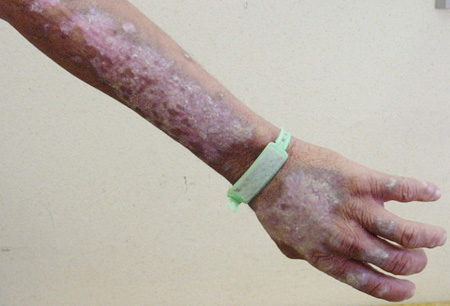Summary
Definition
History and exam
Key diagnostic factors
- dermatitis
- insomnia, depression, or memory loss
- intermittent stupor
- hallucinations or delirium
- weakness
- peripheral neuropathy
- oppositional hypertonus or myoclonus
- cogwheel rigidity
- primitive reflexes
- ataxia
- nausea, vomiting, or diarrhea
- glossitis, cheilitis, or stomatitis
Other diagnostic factors
- fatigue
- anxiety or paranoia
- anorexia, weight loss, or cachexia
- headache
- vertigo
- incontinence
- constipation
- heartburn
- angular palpebritis
Risk factors
- malnutrition
- chronic alcohol use disorder
- vitamin B2 (riboflavin) deficiency
- vitamin B6 (pyridoxine) deficiency
- malabsorption
- eating disorders
- Hartnup disease
- carcinoid syndrome
- antituberculous drugs
- Crohn disease
- HIV infection
- copper deficiency
- certain drugs
- pregnancy and lactation
- age >65 years
- Alzheimer disease
- Parkinson disease
Diagnostic tests
1st tests to order
- serum tryptophan
- urinary N-methylnicotinamide
- urinary N-methyl-2-pyridone-5-carboxamide
- urinary 2-pyridone/N-methylnicotinamide ratio
- skin biopsy
- photosensitivity testing
- CBC
- serum albumin
- serum protein
- LFTs
- gamma-GT
Tests to consider
- serum total iron
- iron-binding capacity
- ferritin
- transketolase activity
- thiamine pyrophosphate (TPP)
- riboflavin coefficient
- serum pyridoxal-5-phosphate
- serum cyanocobalamin
- serum folic acid
- red cell folic acid
- stool exam
- neutral aminoaciduria
- serum serotonin
- platelet serotonin
- urinary 5-hydroxyindoleacetic acid
- HIV antibodies
- mental state exam
- ECG
Treatment algorithm
asymptomatic (marginal deficiency)
symptomatic (pellagra)
Contributors
Authors
Whadi-ah Parker, PhD, RD(SA)
Senior Research Specialist
Centre for the Study of the Social and Environmental Determinants of Nutrition
Population Health, Health Systems and Innovation
HSRC
Cape Town
South Africa
Disclosures
WP declares that she has no competing interests.
Zandile J Mchiza, RD, PhD
Professor
School of Public Health
University of the Western Cape
Cape Town
South Africa
Disclosures
ZJM declares that she has no competing interests.
Acknowledgements
Dr Whadi-ah Parker and Dr Zandile J Mchiza would like to gratefully acknowledge Dr Demetre Labadarios and Dr Nelia Patricia Steyn, as previous contributors of this topic, as well as Miss Nophiwe Job, Ms Nwabisa Tshefu, and Mr Machoene Derrick Sekgala for their contributions to this topic. DL, NPS, NJ, NT, and MDS declare that they have no competing interests.
Peer reviewers
Alan Shenkin, MB, ChB, BSc, PhD, FRCP, FRCPath
Emeritus Professor of Clinical Chemistry
University of Liverpool
UK
Disclosures
AS declares that he has no competing interests.
Alfredo Morabia, MD, PhD, MS
CBNS
Queens College
City University of New York
NY
Disclosures
AM declares that he has no competing interests.
Peer reviewer acknowledgements
BMJ Best Practice topics are updated on a rolling basis in line with developments in evidence and guidance. The peer reviewers listed here have reviewed the content at least once during the history of the topic.
Disclosures
Peer reviewer affiliations and disclosures pertain to the time of the review.
References
Key articles
Janice LR, Kelly M. Krause and Mahan’s Food and the Nutrition Care Process. 16th ed. St. Louis, MO: Elsevier; 2022.
Janos Z, John WS, Jesse FG III, et al. Handbook of vitamins. 5th ed. Boca Raton, FL: CRC Press; 2013.
Sauberlich HE. Laboratory tests for the assessment of nutritional status. 2nd ed. Boca Raton, FL: CRC Press; 1999:161-174.
Reference articles
A full list of sources referenced in this topic is available to users with access to all of BMJ Best Practice.

Differentials
- Dermatitis
- Diarrhea
- Dementia
More DifferentialsGuidelines
- 2020-2025 Dietary Guidelines for Americans
- Evaluation of the nutritional status and growth in refugee children during the domestic medical screening examination
More GuidelinesPatient information
Anorexia
More Patient informationLog in or subscribe to access all of BMJ Best Practice
Use of this content is subject to our disclaimer